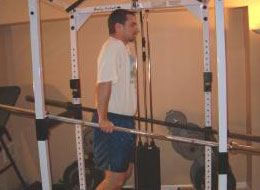|
Power Rack Dips - A Unique Set-Up For a More Powerful Dip
 The dip should be a staple of any complete strength and muscle-building routine. It's one of the best upper-body movements you can do. But what do you do if you don't have dipping bars in your gym? Are you doomed to miss out on all the incredible benefits this exercise has to offer? Not anymore.
The dip should be a staple of any complete strength and muscle-building routine. It's one of the best upper-body movements you can do. But what do you do if you don't have dipping bars in your gym? Are you doomed to miss out on all the incredible benefits this exercise has to offer? Not anymore.
Just because you don't have dipping bars in your gym doesn't mean you can't do dips. In fact, the dipping set-up I'm going to show you is much more versatile even than bars that are built specifically for the exercise!
In order to use this technique, all you will need is a power rack and two Olympic bars. That's it.
First, set the safety rails in the rack to approximately chest height. Now set two Olympic bars on top of the safety rails about 18 inches apart and voila! You've got a dip station. You can choose to set the bars perfectly parallel or set them in a V-shape (I prefer a V-shape for best results).
But the functionality of this set-up doesn't end with it just being a simple dip station. You can take your dipping to a whole new level with the following techniques:
1. Partial Dips
Instead of setting the safety rails at chest level, set them at just above waist level. When you are standing in between the bars, you will notice that you only have a few inches in the top range of motion in the exercise now.
The partial top-range dip is excellent if you are just beginning with dips and need to build up strength or if you are an advanced trainer doing heavy partials with extra weight (either on a hip belt or with a dumbell between your feet). Instead of climbing up onto something or using an elaborate set-up to do partials all you need to do is adjust the height of the safety rails!
2. Negative dips
The negative dip is very useful for building up strength in all levels of trainer from beginner to advanced. If you are a beginner and have trouble doing full reps with your bodyweight, you can almost always at least lower yourself down under control. If you are an advanced trainer, add some weight to yourself and do heavy negatives!
Set the safety rails somewhat lower than your waist so that your arms are straight when you're in a standing position. Set your hands on the bar then bend your knees, lifting your feet off the ground. Lower yourself to the ground slowly until you are either kneeling on the floor or until you have lowered as far as you can safely go. Stand up, set your hands on the bar and repeat the movement.
3. Incline and Decline Dips
These unique variations are only possible using the Power Rack Dip set-up. To do the incline and decline dip, set one safety rail higher than the other then set the bars on top. The one rail can range from being only a few inches higher to as much as a foot or more. The higher the other bar, the more challenging the exercise will be.
 Set the bars parallel to each other on the rails for this variation. The collars on the higher ends of the Olympic bars should be braced up against and hooked onto the safety rails so that the bars don't slide as you're doing the exercise. You can even put weight plates on the ends to ensure they don't go anywhere.
Set the bars parallel to each other on the rails for this variation. The collars on the higher ends of the Olympic bars should be braced up against and hooked onto the safety rails so that the bars don't slide as you're doing the exercise. You can even put weight plates on the ends to ensure they don't go anywhere.
To do incline dips, set yourself so that you are facing the higher end of the bars. In this variation, gravity will not only be pushing you down but also pushing you backwards. This places more tension on the triceps because you not only have to push yourself up, you have to also constantly push yourself forward to keep from falling backwards.
To do decline dips, all you have to do is face the other way. Turn around and face the lower ends of the bars. Now the stress on the triceps is different because you must constantly lean back to keep from falling forward. Leaning back during the dip is a great way to increase tricep involvement--this version forces you to do it.
4. Travelling Incline and Decline Dips
This is the most challenging version of the dip. You must have very good dipping strength in order to properly do this movement.
Start with the incline dip. Set yourself up at the very low end of the bars, facing the top. Lower yourself into the bottom of the dip then push yourself explosively up and slightly forward. You should end up slightly higher on the bars. Repeat the movement, shifting yourself a little higher with each explosive rep until you get to the very high end of the bars.
Set yourself back down on the ground, turn around and do the same thing back down in decline dips. It will be a little easier to move yourself forward because you won't be climbing in altitude. Don't let that fool you, though. Remember, you'll have to catch yourself each time you move forward!
Catching yourself on each rep is exactly like doing plyometrics for your triceps (Note: plyometric exercise is basically catching yourself then explosively pushing back up again. For example, when you jump up in the air, land, then jump back up again, that's a plyometric movement. Plyometric exercises are very effective for building explosive strength and power.). Repeat this procedure all the way back down to the bottom of the bars. If you're still feeling good, try and go back up and down again.
Travelling Incline and Decline Dips will build tremendous explosive power in the pushing muscles of the upper body. Not only are you doing explosive movements on the way up, you're doing plyometric movements on the way down. This can translate into dramatic improvements in exercises such as the bench press.
With the information in this article, it's time to unleash your upper body strength and muscle mass potential. The dip is one of the all-time great upper body exercises. Work it hard and you will be guaranteed results!

More Articles by Author Nick Nilsson
Return To Weight Lifting Articles Archive
|